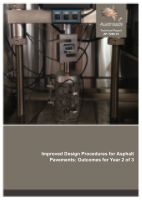Pavement

- Publication no: AP-T296-15
- ISBN: 978-1-925294-48-4
- Published: 3 July 2015
- PDF (free) Download
The report covers a variety of topics related to improving the design procedures for asphalt pavements in Australia. Literature reviews of perpetual pavement design concepts and the relationship between flexural and compressive modulus were performed. Comparative laboratory flexural and compressive modulus testing was conducted part of the study as well. Changes to the Austroads test method for characterisation of flexural modulus and fatigue performance were proposed. Additional work was done to validate the pavement temperature prediction models developed in the previous year of the study. Finally, viscoelastic analysis of asphalt pavements was performed to assess the effect of temperature and loading time on asphalt moduli values at depth.
- Summary
- 1. Introduction
- 1.1. Background
- 1.2. Objectives for 2013–14 Financial Year
- 1.3. Report Structure
- 2. Literature Review on Perpetual Pavements
- 2.1. The Perpetual Asphalt Pavement Concept
- 2.2. Field-based Evidence for the Perpetual Pavement Concept
- 2.3. Laboratory Evidence for Fatigue Endurance Limit
- 2.3.1. General
- 2.3.2. NCHRP Project 9-44A
- 2.4. Discussion on Possible Inclusion of Perpetual Pavement Design Concepts in the Austroads Guide to Pavement Technology
- 3. Asphalt Modulus
- 3.1. Determination of Design Moduli
- 3.2. Flexural Modulus
- 3.3. Compressive Modulus
- 3.3.1. Standard Test Protocols
- 3.3.2. Sample Preparation
- 3.3.3. Equipment
- 3.3.4. Data Collection
- 3.4. Relationship between Compressive and Flexural Modulus
- 3.5. Discussion of Flexural and Compressive Modulus
- 4. Modulus Experiments
- 4.1. Measurement of the Modulus
- 4.2. Flexural Modulus Characterisation
- 4.3. Compressive Modulus Characterisation
- 4.4. Comparing Flexural and Compressive Modulus Results
- 4.5. Discussion of Flexural vs Compressive Modulus
- 5. Improved Procedures for Flexural Modulus Characterisation
- 5.1. Current Austroads Procedure to Determine the Design Modulus
- 5.2. Proposed Procedure
- 6. Improved Procedures for Fatigue Characterisation
- 6.1. Review of Flexural Fatigue Test Procedure
- 6.1.1. Load Conditions
- 6.1.2. Experimental Comparison of Haversine vs Sine
- 6.1.3. Temperature Conditions
- 6.1.4. Number of Specimens
- 6.1.5. Improving Dissipated Energy Calculation
- 6.2. Potential for Mix-specific Fatigue Models
- 6.2.1. Mix-specific Fatigue Models
- 6.2.2. Comparison between Shell Fatigue Model and Mix-specific Fatigue Results
- 6.3. Discussion on Improved Characterisation of Asphalt Fatigue Performance within the AGPT Framework
- 7. Pavement Temperature Prediction Models
- 7.1. Introduction
- 7.2. Instrumented Pavements in Australia
- 7.3. Further Validation of Temperature Prediction Models
- 7.4. Future Improvements of the Pavement Temperature Prediction Models
- 7.5. Explorative Study of Various Temperature Characterisation Concepts in Pavement Design
- 7.5.1. Pavement Design Based on Hourly Traffic and Temperature Data
- 7.5.2. Pavement Design Temperature and Traffic Histograms
- 7.6. Discussion of Pavement Temperature Prediction Models
- 8. Effect of Pavement Temperature and Traffic Speed on Asphalt Strain and Modulus
- 8.1. Introduction
- 8.2. Viscoelastic Material Properties
- 8.3. Asphalt Pavement Viscoelastic Response to Rolling Wheel Load
- 8.3.1. Range of Simulated Pavement Conditions
- 8.3.2. Effect of Asphalt Temperature on the Calculated Asphalt Peak Strains
- 8.3.3. Effect of the Asphalt Thickness
- 8.3.4. Effect of the Traffic Speed
- 8.4. Definition of the Equivalent Asphalt Modulus
- 8.5. Comparison with the Austroads Relationships
- 8.5.1. Effect of Asphalt Temperature
- 8.5.2. Effect of Loading Speed
- 8.5.3. Effect of Asphalt Thickness
- 8.6. Effect of Change in WMAPT with Asphalt Thickness
- 8.7. Findings from the Viscoelastic Analysis of Asphalt Pavements
- 9. Conclusions and Further Work
- 9.1. Conclusions
- 9.1.1. Perpetual Pavement Design Concepts
- 9.1.2. Relationship between Flexural and Compressive Modulus
- 9.1.3. Improved Characterisation of Flexural Modulus
- 9.1.4. Improved Characterisation of Fatigue Performance
- 9.1.5. Pavement Temperature Prediction Models
- 9.1.6. Viscoelastic Pavement Responses Analysis
- 9.2. Implementation of Improvements
- 9.3. Proposed Tasks for 2014–15 Financial Year
- References
